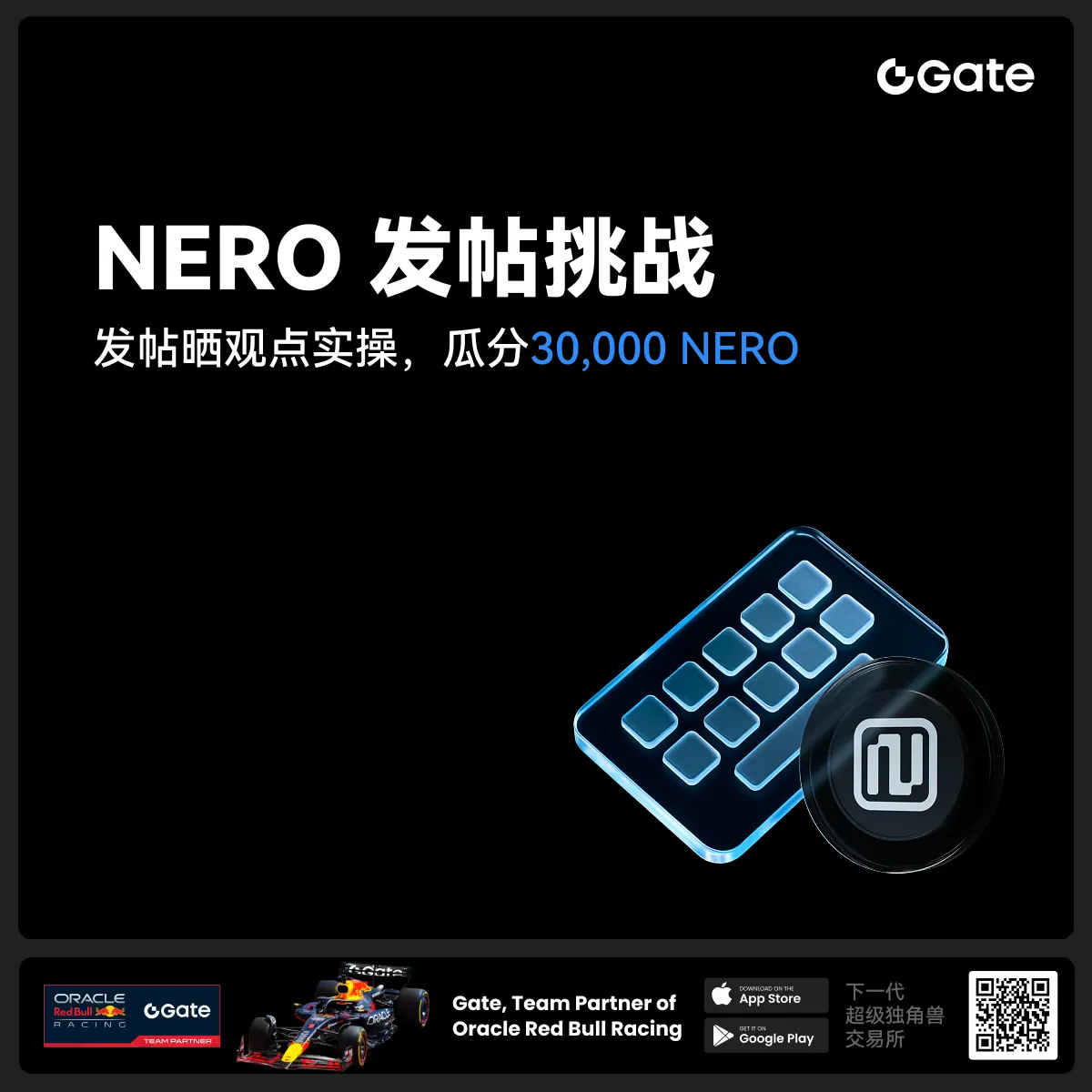- 話題1/3
14k 熱度
167k 熱度
21k 熱度
33k 熱度
94k 熱度
- 置頂
- 👀 家人們,最近你們都攢了多少 Alpha 積分啦?
空投領到了沒?沒搶到也別急,廣場給你整點額外福利!
🎁 曬出你的 Alpha 收益,咱們就送你$200U代幣盲盒獎勵!
🥇 積分最高曬圖用戶 1 名 → $100 代幣盲盒
✨ 積分榜前五優質分享者 5 名 → 各得 $20 代幣盲盒
📍【怎麼玩】
1️⃣ 帶上話題 #晒出我的Alpha积分收益# 發廣場貼
2️⃣ 曬 Alpha 積分截圖 + 一句話總結:“我靠 Gate Alpha 賺了 ____,真的香!”
👉 還可以分享你的攢分技巧、兌換經驗、積分玩法,越乾貨越容易中獎!
📆【活動時間】
8月4日 18:00 - 8月10日 24:00 (UTC+8)
- 🎉 #CandyDrop合约挑战# 正式開啓!參與即可瓜分 6 BTC 豪華獎池!
📢 在 Gate 廣場帶話題發布你的合約體驗
🎁 優質貼文用戶瓜分$500 合約體驗金券,20位名額等你上榜!
📅 活動時間:2025 年 8 月 1 日 15:00 - 8 月 15 日 19:00 (UTC+8)
👉 活動連結:https://www.gate.com/candy-drop/detail/BTC-98
敢合約,敢盈利
- 🎉 攢成長值,抽華爲Mate三折疊!廣場第 1️⃣ 2️⃣ 期夏季成長值抽獎大狂歡開啓!
總獎池超 $10,000+,華爲Mate三折疊手機、F1紅牛賽車模型、Gate限量週邊、熱門代幣等你來抽!
立即抽獎 👉 https://www.gate.com/activities/pointprize?now_period=12
如何快速賺成長值?
1️⃣ 進入【廣場】,點擊頭像旁標識進入【社區中心】
2️⃣ 完成發帖、評論、點讚、發言等日常任務,成長值拿不停
100%有獎,抽到賺到,大獎等你抱走,趕緊試試手氣!
截止於 8月9日 24:00 (UTC+8)
詳情: https://www.gate.com/announcements/article/46384
#成长值抽奖12期开启#
- 📢 Gate廣場 #NERO发帖挑战# 秀觀點贏大獎活動火熱開啓!
Gate NERO生態周來襲!發帖秀出NERO項目洞察和活動實用攻略,瓜分30,000NERO!
💰️ 15位優質發帖用戶 * 2,000枚NERO每人
如何參與:
1️⃣ 調研NERO項目
對NERO的基本面、社區治理、發展目標、代幣經濟模型等方面進行研究,分享你對項目的深度研究。
2️⃣ 參與並分享真實體驗
參與NERO生態周相關活動,並曬出你的參與截圖、收益圖或實用教程。可以是收益展示、簡明易懂的新手攻略、小竅門,也可以是行情點位分析,內容詳實優先。
3️⃣ 鼓勵帶新互動
如果你的帖子吸引到他人參與活動,或者有好友評論“已參與/已交易”,將大幅提升你的獲獎概率!
NERO熱門活動(帖文需附以下活動連結):
NERO Chain (NERO) 生態周:Gate 已上線 NERO 現貨交易,爲回饋平台用戶,HODLer Airdrop、Launchpool、CandyDrop、餘幣寶已上線 NERO,邀您體驗。參與攻略見公告:https://www.gate.com/announcements/article/46284
高質量帖子Tips:
教程越詳細、圖片越直觀、互動量越高,獲獎幾率越大!
市場見解獨到、真實參與經歷、有帶新互動者,評選將優先考慮。
帖子需原創,字數不少於250字,且需獲得至少3條有效互動
- 🎉 親愛的廣場小夥伴們,福利不停,精彩不斷!目前廣場上這些熱門發帖贏獎活動火熱進行中,發帖越多,獎勵越多,快來GET你的專屬好禮吧!🚀
1️⃣ #GateLaunchpad上线IKA# |IKA認購體驗
在Gate廣場帶話題曬出你的IKA Launchpad認購體驗,4位幸運分享者講瓜分$200分享獎池!
詳情 👉️ https://www.gate.com/post/status/12566958
2️⃣ #ETH冲击4800# |行情分析預測
大膽發帖預測ETH走勢,展示你的市場洞察力!10位幸運用戶將平分0.1 ETH 獎勵!
詳情 👉️ https://www.gate.com/post/status/12322403
3️⃣ #创作者活动第二期# |ZKWASM話題
在廣場或推特發布與 ZKWASM 或其交易活動相關的原創內容,瓜分4,000枚ZKWASM!
詳情 👉️ https://www.gate.com/post/status/12525794
4️⃣ #Gate广场征文活动第二期# |ERA話題
談談你對ERA的觀點/體驗,參與並推廣活動,700 ERA大獎等你贏!
詳情 👉️ https://www.gate.com/post/status/12361653
5️⃣ #MBG任务挑战# |MBG話題
分享你對MBG的洞察,積極參與和推廣MBG活動,20位小
DeFi will become the default financial interface
Opinion by: Vikram Arun, co-founder and CEO of Superform
DeFi already moves billions of dollars daily, lets anyone create new assets in minutes and rewards users with yields that banks can’t match. Using one app to find opportunities, another to bridge, a third to swap, a fourth to deposit and yet another to track your position — all while juggling wallets, chains and gas settings — doesn’t feel like a financial revolution. It’s more like a flight simulator where most pilots crash on the runway.
That complexity must disappear if crypto upgrades global finance and surpasses the earliest risk-takers. But the answer isn’t just another protocol. It’s a re-architecture of how DeFi is built and used. One that pairs ownerless, composable infrastructure with productized, intuitive interfaces.
This depends on two missing layers in today’s DeFi stack: the Hyperstructure and the Superapp
Hyperstructures are the internet back-end of money
The foundation of this new stack is what we call a hyperstructure. First theorized by Jacob Horne, hyperstructures are protocols that are free to use, valuable to govern and built to last. To support superapps, a hyperstructure must empower builders, as it rewards users and investors. It is permissionless and decentralized, with incentives to improve and add to the protocol. It is also free to use, but valuable to own and govern.
Hyperstructures can be created for all kinds of use cases, like trading platforms like Uniswap and Curve, and creator networks like Zora and Farcaster. These platforms began as protocols and are now evolving into ecosystems, offering the backbone for the next generation of applications, aka the superapp.
Related: Stop making crypto complex
The most urgent frontier is building a hyperstructure for one of money’s most basic functions: growing itself. Historically, the ability to grow wealth, through savings, investing and yield, has been heavily permissioned and gatekept. Crypto made transferring money permissionless. With hyperstructures, we can make growing money permissionless, too.
DeFi’s rapid growth revealed a problem. In scaling yield, many projects adopted models that leaned heavily on centralized APIs, privileged roles and opaque offchain arrangements. The experience appealed to a narrow cohort of users with high risk tolerance and institutional connections. It contradicted the core principles that made crypto valuable in the first place.
Superapps support seamless UX on permissionless rails
That’s where the superapp comes in. It takes the fragmented chaos of DeFi and condenses it into a single, intuitive experience. For this to work, the earn layer needs dedicated infrastructure that expands access to yield while solving two key problems: discovery and execution.
Discovery automatically surfaces a comprehensive menu of earning opportunities with reliable onchain data so issuers don’t have to apply, promote themselves or rely on centralized listings. Execution compresses complex workflows into one atomic transaction, giving every user the same superpowers.
Doing so requires separating the fast-moving product layer from a slower, neutral base that is naturally far more resilient and secure with a lower cost of capital. Anyone can deploy, extend or fork the base without requesting permission. Yet, it must still be able to ship modern primitives that rival the convenience of today’s centralized platforms.
DeFi that feels like fintech
As the base layer standardizes, experience becomes the differentiator. Superapps turn raw infrastructure into products people want to use. You open the app and see familiar tools: “Cash Now,” “Savings,” “Highest Return.” Tap one, and the app automatically bridges, swaps and deposits, all behind the scenes. The best superapps will win on speed, strategy, support and design. The hyperstructure is the engine; users fall in love with the car.
Here’s the catch: If we optimize only for experience and neglect neutrality, DeFi risks becoming fintech in disguise. Centralized vaults. Opaque risk. Silent governance. That’s the danger. And that’s exactly what hyperstructures are meant to prevent
Some will argue that users don’t care about decentralization. Others will say good design justifies centralization. But crypto was never about short-term convenience; it was about long-term power. If we lose that, we lose the point.
In the 2000s, few imagined streaming 4K video across devices over a single protocol. Today, it’s second nature. The same will happen with money. People won’t ask whether they’re “using DeFi.” They’ll just be using money… on open, invisible, and unstoppable rails.
DeFi doesn’t scale as a patchwork of protocols. It scales as a new financial interface. Hyperstructures provide the foundation. Superapps deliver the experience. When they’re aligned, the result is more than just better apps. It’s a better system
Opinion by: Vikram Arun, co-founder and CEO of Superform.
This article is for general information purposes and is not intended to be and should not be taken as legal or investment advice. The views, thoughts, and opinions expressed here are the author’s alone and do not necessarily reflect or represent the views and opinions of Cointelegraph.